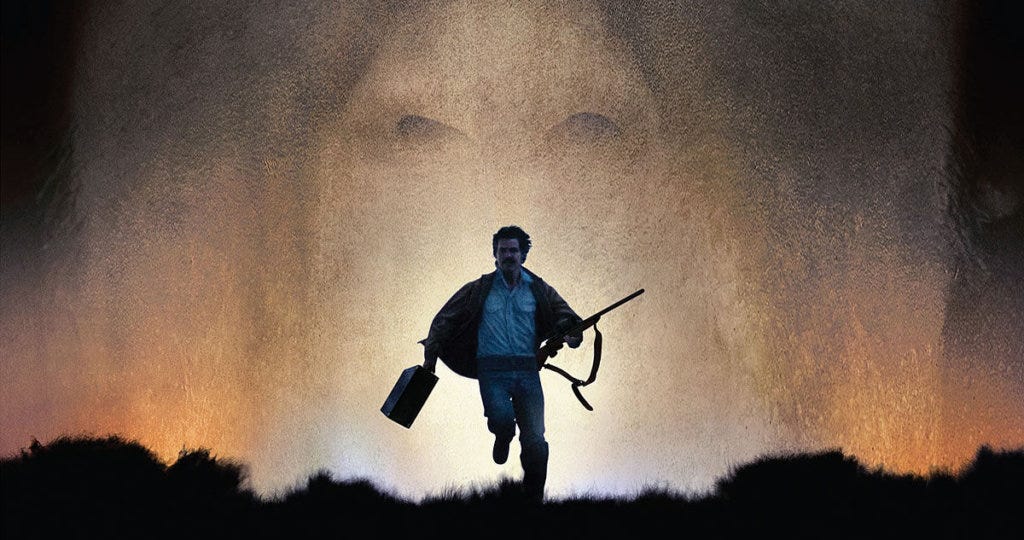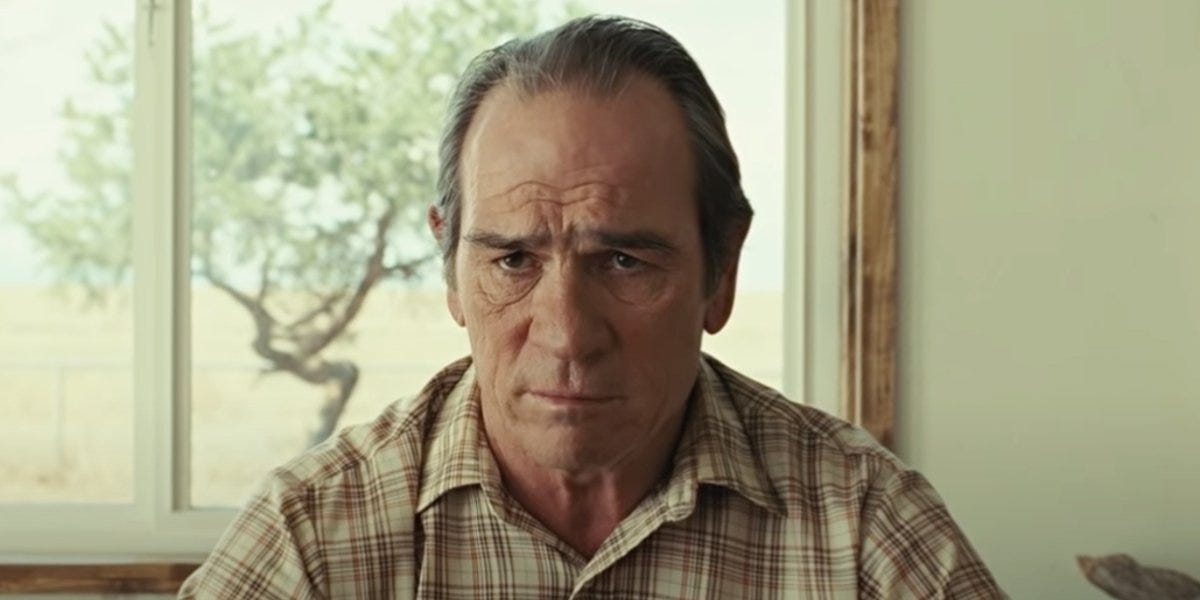"Souls at Hazard": No Country For Old Men, Revisited
Subtextual Healing Film Club #1
Today kicks off a six week '“film club” where I’ll revisit a selection of movies that I personally love and want to write and talk about. If you’re reading this I hope that you’ll either watch or rewatch these films and then join in the conversation (I love people reading my work, but dialogue is even better). I won’t be offering summaries of these movies (and there will be spoilers) but I’ll be dividing my reviews into sections, as followed:
What are my initial thoughts after watching this time around?
What makes this film stand out and what continues to resonate?
Let’s get subtextual. What lies beneath this piece of art?
Interesting details and trivia about the film
Final impressions and notes
Thanks for reading along! Here we go…
The crime you see now, it's hard to even take its measure. It's not that I'm afraid of it. I always knew you had to be willing to die to even do this job. But, I don't want to push my chips forward and go out and meet something I don't understand. A man would have to put his soul at hazard. He'd have to say, "OK, I'll be part of this world." - Sheriff Ed Tom Bell
1. What are my initial thoughts after watching this time around?
Javier Bardem’s Anton Chigurh is still the most terrifying villain I have ever seen on film. I recall after my first viewing that I checked my bedroom and shower when I got home from the theater. I was 25 years old.
This is also one of my all-time favorite performances by Tommy Lee Jones. He gets some of the best lines of dialogue but also expresses so well with his eyes and body language overall in this picture.
I never knew that a dog swimming could be so terrifying.
No Country For Old Men has so many parallels to the Coens’ earlier, comedic work in Raising Arizona: A seemingly unstoppable and evil bounty hunter, a husband taking a shortcut to accomplish their dreams, funny and awkward interactions with gas station attendants, and dry and harsh landscapes. Just to name a few.
Sparse dialogue and minimal music means that the audience focuses much more on behaviors and actions, body language, facial expressions, and the surrounding environment.
Do yourself a favor and watch every film in which Roger Deakins is the cinematographer. He’s truly a master of his craft.
I love how this film transitions from scene to scene. The fading of one act bleeding into the next makes for a more reflective work of art. I’ve noticed that HBO’s Barry utilizes a lot of these transitions as well. It’s effective and works to unite the narratives.
2. What makes this film stand out and what continues to resonate?
I have always loved the extra characters in this film. They all feel lived in and real and complex and it is nearly perfectly cast (I know the Coen brothers were desperate for a bit of comic relief, but Carla Jean’s mom is a little over the top. Also, her character is supposed to be 58 years old. What?!). I especially want to highlight actor Kathy Lamkin, the trailer park manager. What a performance! I think more than any character in the film, she gives Anton Chigurh the most grief.
This movie has less than sixteen minutes of music, but still has an amazing soundtrack. The real music is the collection of sounds that punctuate each scene: the crunching of boots on dried ground, the wind rustling through the open landscapes, creaking wood floors, the cocking of pistols, crackling food wrappers, and flies buzzing over dead bodies.
This picture defied genre expectations. Is it a western? Neo-western? Noir? Gothic? A straightforward thriller? In some ways it represents all of these, shuns and subverts these conventions, and mixes them altogether. Who does this film belong to and is there a central character? Llewelyn seems to be for much of it and then is abruptly killed off-screen. I know the way in which he met his end bothered so many people, but it’s a master stroke to upend what we expect to happen. It corresponds exactly to a central message of the film. The mayhem cuts quick, hits deep, and doesn’t take into consideration our expectations or wishes.
3. Let’s get subtextual. What lies beneath this piece of art?
Two of my favorite films of the 21st century made their debut in 2007, There Will Be Blood and No Country For Old Men. Both examine intricately an obsession with violence and greed, speak realistically to our fragility, and expound truthfully on America’s more troubling values and traits. No Country For Old Men ended up winning Best Picture that year and I can’t say that it was an unjust victory (even though P.T. Anderson’s film might be my favorite of the two). What sticks with me now, fifteen years later, is how relevant this movie is to our present moment. We are in a world and country that is racked with violence and so many of us feel “overmatched”, to quote Ed Tom Bell. We are dumbfounded by witnessing these acts and we don’t have an answer or an approach that will stem the tide.
No one gets away clean in this film, which is of course analogous to our own experiences in life. We may not all directly deal with the level of chaos that these characters find themselves in but we are all mired in the complexities of existence. A couple of times in the movie, characters speak about “what is coming”. The apocalyptic language insinuates that we can never deter or extricate ourselves from the chaos of the world. Even Anton Chigurh tries several times in the film to avoid the excesses of his violence: he moves the shower curtain to avoid the splatter from the gunshot, he places his feet on the bed to keep his boots clean from the spreading blood, he takes his bloodied socks off in a hotel room. But he can’t ever be truly clean and his car crash in the final act proves the point as he walks away from the accident with blood all over and a bone sticking out of his arm.
Anton Chigurh is the most principled of this cast of characters in the sense that he lives by a specific philosophy and code. It’s a delusion, of course, as Carla Jean points out to him near the end of the film. Chigurh is not a vessel of fate or luck, he’s making particular choices and has legitimate agency. Carla Jean deftly challenges his personal ethos, noting that there isn’t some force of inevitability at play other than what he is creating himself. The most genuine and moral characters in the movie, Ed Tom and Carla Jean, are the people that feel the most lost, uncertain, and bewildered by their environment. Which speaks something to the effect that perhaps the most courageous and truthful way we can live in this world is to face it head on without believing that there will be a predictable outcome. Carla Jean does so by calling Chigurh on his illogical coin flip and Ed Tom does so by walking back into the last hotel room, knowing that Chigurh is most likely present. It appears that the only inevitability we can rely on is chaos, or hazard. We’re all souls at hazard in a universe that appears to be indifferent to our desire for peace. Ed Tom’s lament that God never entered his life reflects this mentality.
Greed is something pervasive to us all on various levels. We may not become drug dealers or go on the run after discovering a satchel full of money, but the pursuit of riches often corrupts even in the smallest of moments: Llewelyn has to pay a group of college-aged guys to give him a jacket and a beer, even though he’s clearly wounded and covered in blood. Instead of being decent humans in a moment of vulnerability, they attempt to finagle more cash out of Moss in his time of need. The teenage boys who go to help Anton after his car wreck begin to squabble over the cash that he hands to the young man who donates his shirt. These smaller moments reflect a larger reality, that greed is born in small instances that can eventually lead to the worst of circumstances. They connect intricately to the overall story of greed that is playing out in the film. It’s another act of violence that bubbles to the surface.
4. Interesting details and trivia about the film
Interestingly enough, No Country For Old Men and There Will Be Blood shot scenes in the same area of West Texas at the same time. No Country actually had to shut down production for one day because clouds of dark smoke were rising into the sky because of pyrotechnics from the TWBB shoot.
In the novel, Sheriff Bell says of the dope-dealers, "Here a while back in San Antonio they shot and killed a federal judge." Cormac McCarthy set the story in 1980. In 1979, Federal Judge John Howland Wood was shot and killed in San Antonio by Texas freelance contract killer Charles Harrelson, father of Woody Harrelson (Carson Wells).
The case that held the money was the same case that was also used for the same purpose in Fargo.
At this point in time, this was the longest runtime of a Coen brothers movie at 2 hours and 2 minutes. They know how to tell an efficient story and I wish more directors adopted this approach.
Anton Chigurh’s kill count is fourteen.
The three leads of this film never share any screen time together. Llewelyn and Chigurh have a shootout but never meet face to face. Carla Jean is the only character to interact with all three.
5. Final impressions and notes
The great lines of dialogue:
Man you hires Wells: “Just how dangerous is he?” (talking about Chigurh).
Wells: “Compared to what? The bubonic plague?”
Ellis: “What you got ain't nothin' new. This country's hard on people. You can't stop what's coming. It ain't all waiting on you. That's vanity.”
Wendell: “You think this boy Moss has got any notion of the sorts of sons of bitches that're huntin' him?”
Ed Tom Bell: “I don't know, he ought to. He's seen the same things I've seen, and it's certainly made an impression on me.”
Carla Jean Moss: “Sheriff, was that a true story about Charlie Walser?”
Ed Tom Bell: “Who's Charlie Walser? Oh! Well... uh... a true story? I couldn't swear to every detail but it's certainly true that it is a story.”
Woody Harrelson is also very good in this movie. It’s one of his more understated roles, but still solid.
What always blows me away (no pun intended) about this movie is the final act. Whereas in the novel Ed Tom is the central character, in the Coen brothers film he eventually becomes the main figure over the course of the movie. His lament about his occupation and his inability to respond to the increased violence, his despair that God seems to be silent, and his descriptions of his dreams about his father are just so human and authentic. I remember my first watch of this movie was with my sister and when the movie cuts to black I told her, “That is how you end a movie!”. It’s a gut punch. She did not feel the same.
That’s all, folks. Did you watch the movie? Rewatch it? What do you think?




